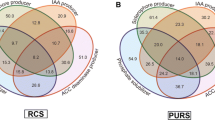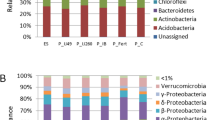Abstract
Long-term experimental fields (having either no nitrogen, phosphorus, or potassium fertilizer or with complete application of N, P, and K fertilizers since 1914) were used for the investigation of bacterial habitat distribution in the rhizosphere. From the rhizosphere of Lupinus albus L., we screened rhizobacteria by their utilization ability of phytate as sole carbon (C) and phosphorus (P) source. Though almost all of the isolates were identified as Burkholderia genus, there was a wide variation in their phosphate utilization. By comparing isolates from rhizosphere soil and isolates from the rhizoplane, those isolates from the latter exhibit higher inorganic phosphate uptake ability when compared at the same extracellular phytase level. We propose that phytate-utilizing bacteria may adapt and segregate from their habitat along a spatial gradient of C and P availability in the rhizosphere. That is, rhizobacteria, which live very close to the rhizoplane, utilize phytate mainly as a P source rather than as a C source, because a large amount of C is provided from roots, whereas this may not be true for P. On the other hand, rhizosphere bacteria that live in a remote area from roots utilize phytate as a C source rather than as a P source, because the lack of available C may restrict the growth of bacteria.
Access this chapter
Tax calculation will be finalised at checkout
Purchases are for personal use only
Preview
Unable to display preview. Download preview PDF.
Similar content being viewed by others
References
Balandereau J, Viallard V, Cournoyer B, Coenye T, Laevens S, Vandamme P (2001) Burkholderia cepacia genomovar III is a common plant-associated bacterium. Appl Environ Microbiol 67: 982–985
Coenye T, Schouls LM, Govan JRW, Kersters K, Vandamme P (1999) Identification of Burkholderia species and genomovars from cystic fibrosis patients by AFLP fingerprinting. Int J Syst Bacteriol 49: 1657–1666
Dalai RC (1977) Soil organic phosphorus. Adv Agron 29: 83–117
Hiltner L (1904) Über neuere Erfahrungen and Probleme auf dem Gebiet der Bodenbakteriologie and unter besonderer Berücksichtingung der Gründüngung and Brache. Arb Dtsch Landw Ges 98: 59–78
Hiraishi A (1992) Direct automated sequencing of 16S rDNA amplified by polymerase chain reaction from bacteria cultures without DNA purification. Lett Appl Microb 15: 210–213
Ishizawa S, Suzuki T, Sato O, Toyoda H (1958) Studies on microbial population in the rhizosphere of higher plants with special reference to the method of study. Plant Soil Food 3: 85–94
LiPuma JJ (1998) Burkholderia cepaciea. Management issues and new insights. Curr Opin Pulm Med 4:337–341
Moulin L, Munive A, Dreyfus B, Boivin-Masson C (2001) Nodulation of legumes by members of beta-subclass of proteobacteria. Nature 411: 948–950
Murphy J, Riley JP (1962) A modified single solution method for the determination of phosphate in natural waters. Anal Chim Acta 27: 31–36
Richardson AE, Hadobas PA (1997) Soil isolates of Pseudomonas spp. that utilize inositol phosphates. Can J Microbiol 43: 509–516
Sullivan JT, Ronson CW (1998) Evolution of rhizobia by acquisition of a 500-kb symbiosis island that integrates into a phe-tRNA gene. Proc Natl Acad Sci USA 95: 5145–5149
Van Elsas JD, Gardener BB, Wolters AC, Smit E (1998) Isolation, characterization, and transfer of cryptic gene-mobilizing plasmids in the wheat rhizosphere. Appl Environ Microbiol 64: 880–889
Yabuuchi E, Kosako Y, Oyaizu H, Yano I, Hotta H, Hashimoto Y, Ezaki T, Arakawa M (1993) Proposal of Burkholderia gen. nov. and transfer of seven species of the genus Pseudomonas homology group II to the new genus, with the type species Burkholderia cepasia (Palleronhi and Holmes 1981) comb. nov. Microbiol Immunol 36: 1251–1275
Author information
Authors and Affiliations
Editor information
Editors and Affiliations
Rights and permissions
Copyright information
© 2004 Springer-Verlag Berlin Heidelberg
About this paper
Cite this paper
Unno, Y., Shinano, T., Wasaki, J., Osaki, M. (2004). Micro-spatial Distribution of Bacteria in the Rhizosphere. In: Werner, D. (eds) Biological Resources and Migration. Springer, Berlin, Heidelberg. https://doi.org/10.1007/978-3-662-06083-4_14
Download citation
DOI: https://doi.org/10.1007/978-3-662-06083-4_14
Publisher Name: Springer, Berlin, Heidelberg
Print ISBN: 978-3-642-05989-6
Online ISBN: 978-3-662-06083-4
eBook Packages: Springer Book Archive




